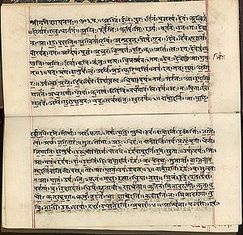Early Religions
Vedic
by Sean Kosecki

Vedas, the holy scripture of the Vedic religion
The Vedic Religon, is composed of Indo-European speaking who migrated from present day Iran to India from 1500-500 B.C.E. The belief system of the Vedic religon is no the platofrm for what is Hinduism.Vedic people worship both elements such as fire and rivers; as well as worshiping gods such as Indra, the god of war. The Vedic people get their name from the 4 vedas, or holy scripts written in Sanskrit. The four Vedas emphasize to followers of the religion the importance, of skepticism. Vedics believe that one shouldn't believe everything they hear and take it for the truth. Vedic principles encourage followers to use systematic logic and reasoning to become more successful members and thinkers of society. This is a significant step for people because it shows the first signs of logic and reasoning needed to progress intellectually as a society.
Zoroastrianism
by Ali Kalam
Zoroastrian worship site in Persepolis.
Zoroastrianism is a monotheistic religion believed to be founded as early as the 10th century. The religion is about the teachings of Zoroaster and believes in the god Ahura Mazda, the creator of all and all-good upholder of truth. The main principles of Zoroastrianism are free will and happiness. The religion struggled early on, but had some success when it was made the state religion of Bactria. The religion truly thrived when the Cyrus the Great unified the Persians and formed the great Persian empire (modern day Iran) in 550 BCE. The ruling Archaemenian family ruled the empire in a just manner, tolerating all religions and encouraging interfaith relationships. This caused the name and idea of Zoroastrianism to spread to other civilizations and led to good relationships of other lands with the Persians and Zoroastrianism influencing future religions such as Judaism. With the success of the Persian empire, Zoroastrianism flourished in the time of classical antiquity. In 331 BCE, when Alexander the Great conquered the empire, Zoroastrianism was heavily damaged with many texts destroyed and scholars killed. The main text, the Gathas, survived, allowing Zoroastrianism to survive. After Alexander, Zoroastrianism returned under the just rule of the Arcasids in 311 BCE. However, the Arcasids were soon overthrown by the Sasanians and there was no longer any freedom of religion and Zoroastrianism became the state religion of the empire and was no longer used as the tolerant and nice religion it once had the reputation of as non-believers were oppressed. With the Arabs conquering the Sassanid empire in the 7th century, Zoroastrianism declined even more. While the religion was still tolerated, the Zoroastrians were heavily oppressed as being a Muslim was preferred by the government and many advantages were only available to Muslims. Over time, Zoroastrians started getting harassed and eventually started converting or leaving. Many went to India, but many stayed and became Muslims. The Zoroastrians were now a minority in the land they once ruled and had little influence around the world in the early middle ages.
Hebrew Monotheism
by Victor Drucker

"Shema Yisrael, Adonei Elohenu, Adonei Echad" is an antiquated declaration dating back to the origins of the Judaic faith. It translates directly to 'Hear o Israel, the Lord our God, the Lord is One.', and is the foundation of the Hebrew ideology. At the time of Hebrew Monotheisms conception, there were quite a few other monotheistic faiths dabbling the landscape of the middle east, but the Israelites took these concepts of monotheism, borrowed from other cultures worship of the sun, or a fire god, and created the most prevalent faith of the ancient world. There are many theories as to how this happened, according to the Bible, God proffered divine revelations upon Abraham, stating to worship no other gods before him, to consider him omnipotent and omniscient, etc. To Abraham, God made the promise that his descendants would be blessed, and also numbered. Today, most of the Judaic beliefs are relegated from the Pentateuch, the five books of Moses, from sometime around 1500 B.C.E. And as the Abrahamic peoples proliferated across the region, so did their ideologies. Soon enough, Judaism was a prevalent faith, dominating Babylon, Canaan, and many more kingdoms. As the religion grew, there were many adages to the religious text. To the Pentateuch were added epics and tales from King Nebbuchadnasser and Solomon's reigns, and this compilation eventually became what is today known as the "Old Testament."
